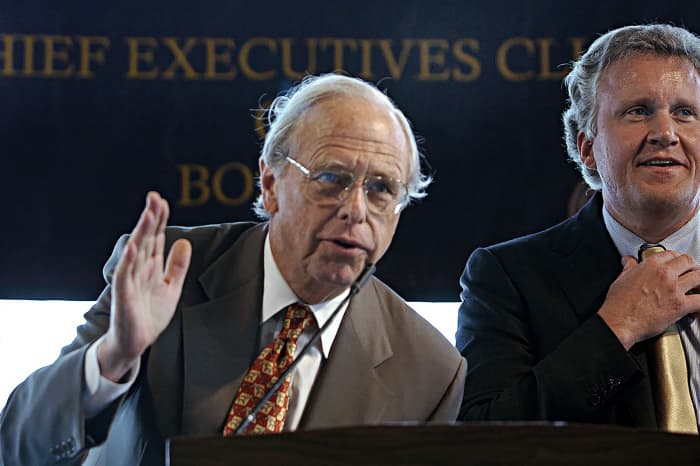This post was originally published on this site
Few of us change the world for the better. Edward “Ned” Johnson, III, who became chairman and CEO of Fidelity Investments in 1977 when the firm’s assets under management totaled $3.9 billion, is among those few.
In fact, millions of households are today investing in mutual funds in their 401(k) plans, IRAs, and other types of accounts thanks in large part to Johnson, who died March 23 at the age of 91.
At the time of his death, Johnson was chairman emeritus of a firm that had $11 trillion in assets under administration representing about 40 million investors. Ned’s daughter Abigail (Abby) became CEO of Fidelity in 2014. (Fidelity was and still is a family business,)
And what a business. Johnson deserves credit for creating a nation of investors by adroitly marketing actively managed low- and no-load mutual funds run by all-star portfolio managers starting in the late 1970s. Johnson is among a trio of giants (and geniuses) who, each in their own way, democratized investing. Jack Bogle, the founder of The Vanguard Group, gets credit for marketing low-cost passively managed index funds and Charles Schwab made buying and selling stocks at a discount an ordinary event.
But it is Johnson who stands out, at least in the mind of Matt Fink, the former president of the Investment Company Institute, as the “most important figure” in mutual fund history. “Under his leadership, Fidelity has introduced a long series of innovations,” Fink wrote in his book, “The Rise of Mutual Funds: An Insider’s View.”
It did indeed. In 1974, for instance, Fidelity introduced the first money market fund that allowed investor to withdraw funds simply by writing a check. By today’s standard, a money-market fund with check-writing privileges is, of course, a de minimis feature. But back then, it was a “remarkable innovation” that was “instantly and widely copied,” as Diana Henriques wrote in her book, “Fidelity’s World.”
Johnson also gets credit for numerous other innovations, including, as Henriques and Fink noted in their respective books, a legacy of investments in such things computer power, investor centers, innovative products (tax-exempt money funds and no-load tax-exempt funds), customer service, as well as some brilliant marketing and public relations. Fidelity spent heavily to make it easy for customers to call a 24-hour toll-free number to talk to a customer service representative and, in doing so, made it hard for other firms in the financial services industry to compete.
Of course, none of that innovation was surprising given two factors. One, under Johnson, Fidelity became known not just for its collection of its unofficial mascot (frogs) but for something called “kaizen,” or continuous improvement. Fidelity was never going to rest on its laurels on Ned’s watch. Two, the company was and still is privately held. Johnson could and did freely spend the company’s profits on all sorts of projects and endeavors.
But of all the innovations, Johnson — who managed the Magellan fund for a bit — will be remembered most for making Fidelity home to some of the greatest mutual-fund managers of all time, including Peter Lynch, Bruce Johnstone, Dorsey Gardner, Leo Dworsky, Barry Greenfield, Joel Tillinghast, Will Danoff, Karen Firestone, Jeff Vinik, and Moshe Smith, to name but a few.
Those and other managers would frequently grace the covers of personal finance and business magazines for their chart-topping performance and become household names. These star managers were the faces of Fidelity and assets flowed in because of them. Given that, Johnson gave his portfolio managers and researchers carte blanche to run their operation as they saw fit. Lynch, for instance, was famous for making big bets on companies that, in some cases, would become 10-baggers.

Edward “Ned” Johnson III, left, in 2002.
AP Photo/Chitose Suzuki
Johnson will also be remembered for his shrewdness and marketing savvy. Fidelity, given the large number of funds it offered and still does (200 or so at last count), always seemed to have more than a few funds on lists of top-performers. Given that, Fidelity was able to take advantage of investors’ tendency to chase hot mutual funds. In essence, money was guaranteed to pour into whatever Fidelity fund appeared on this quarter’s or this year’s list of top-performing funds. It was nothing less than brilliant to offer so many funds.
Also noteworthy is that Johnson, though he was worth an estimated $13.6 billion had — at least to me — a simple way about him. I recall walking in Boston one morning on my way to work and watching a man emerge from the passenger side of a not-so-new station wagon, holding a brown-paper lunch bag in his hand. He strolled into 82 Devonshire St. — Fidelity’s headquarters.
I had to do a double-take.
It was Ned.
Robert Powell is a MarketWatch columnist.
More: Why 401(k) and other retirement savers can be thankful Fidelity’s Ned Johnson was such a visionary
Also read: Saving for retirement is easy enough — spending it is more complicated


